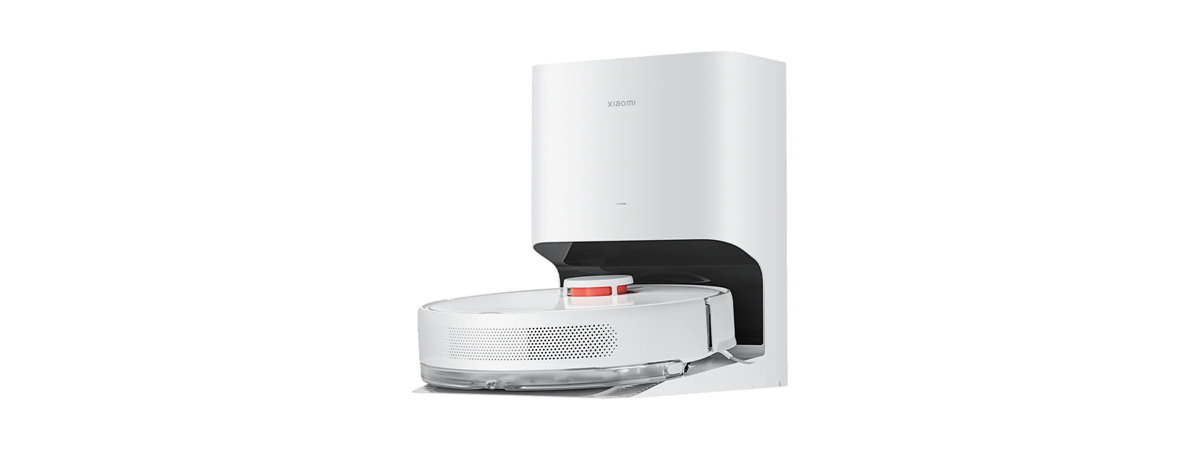
If you’re looking for a smart and relatively affordable robot vacuum, you may want to consider the TP-Link Tapo RV30 Plus. It promises to keep your home clean and dust-free, regardless of the floor types in your rooms. The Tapo RV30 Plus is part of the latest family of smart home devices made by TP-Link, a well-known brand in this industry. In this review, I will show you the features and performance offered by the TP-Link Tapo RV30 Plus, and I’ll also tell you my opinion on the pros and cons of owning it. Hoping that my personal experience with the Tapo RV30 Plus will help you decide if this robot vacuum is the right choice for you, let’s start:
TP-Link Tapo RV30 Plus: Who is it good for?
TP-Link Tapo RV30 Plus is a good choice if you:
- Have a large apartment or an equivalent living/workspace
- Want a device capable of mopping, too, not just dust cleaning
- Like a low-maintenance robot vacuum (with an auto-emptying dock)
- Have hard floors or low pile carpets/rugs (under 2 cm)
- Need a smart robot vacuum that works with Amazon Alexa or Google Home
Pros and cons
The things I like most about the TP-Link Tapo RV30 Plus are:
- Excellent suction power in all modes
- Top-notch LiDAR plus gyroscope system navigation
- Vacuums and mops simultaneously
- Can automatically boost suction power when identifying carpets
- Silent when used in quiet mode
- Useful docking station with large-capacity dust bags
- The Tapo app is easy to use and feature-rich
- Compatible with Amazon Alexa and Google Home
- Well-balanced performance per price ratio
The downside you should consider is the following:
- You need to be careful not to mop carpets too, by accident

Verdict
The TP-Link Tapo RV30 Plus robot vacuum offers plenty of features for a reasonable price. Its suction power is high, the navigation system is good, battery life is excellent, and the docking station includes a self-emptying dustbin. I’m quite satisfied with its performance when cleaning dust and other kinds of debris piling on the floors. This is true for both hard floors and low or medium pile carpets. Mopping is good too, although hardened stains are too tough for the Tapo RV30 Plus to wipe out completely; that’s an issue with most such devices. Overall, I believe that the TP-Link Tapo RV30 Plus is a smart choice for anyone looking for a robot vacuum able to do most of the cleaning tasks at a reasonable cost.
Unboxing the TP-Link Tapo RV30 Plus
The TP-Link Tapo RV30 Plus is shipped in a relatively large box with an almost cubic shape. It’s not very heavy, so you can transport it yourself using the plastic handle on its top side. TP-Link printed a lot of information on the box, including details about its features and specs, as well as some pictures of the robot vacuum.
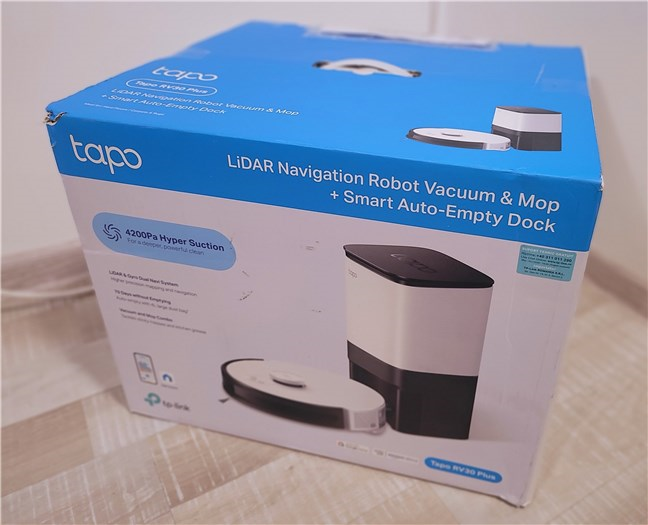
The packaging for TP-Link Tapo RV30 Plus
Inside the box, you’ll find everything you need to get the robot vacuum up and running in no time. The package contents include the robot vacuum cleaner, an auto-empty dock, a mop cloth mount, two washable mop cloths, two disposable dust bags (4 liters each), two side brushes, two HEPA filters, one cleaning brush, and the quick installation guide.
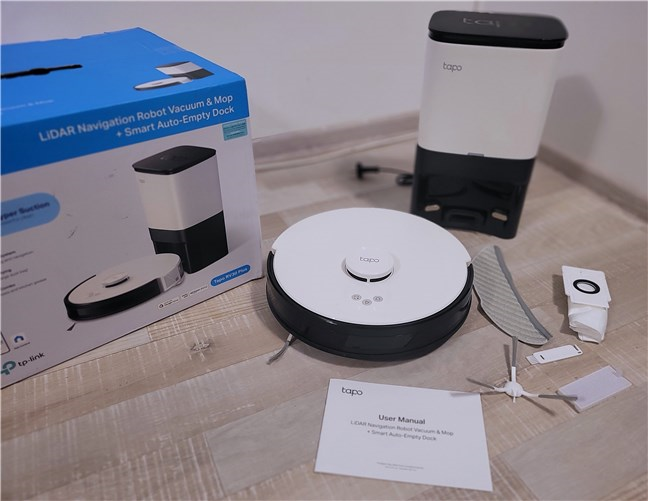
Unboxing the TP-Link Tapo RV30 Plus robot vacuum
Unboxing the TP-Link Tapo RV30 Plus is a satisfying experience. The box and the robot vacuum cleaner look good, and the package bundles everything you need to start using the device immediately, plus some spare accessories.
Design and hardware specifications
In terms of design, the TP-Link Tapo RV30 Plus looks pretty much the same as most other robot vacuums on the market. With a classic round shape and a LIDAR system on top, it would be hard to set it apart from other generic brands if not for the Tapo logo and the black and white distinguishing colors. Its size is also common to such devices: the robot vacuum has a diameter of 34.1 cm and a height of 9.5 cm. If you’re used to the imperial measuring system, that’s 13.4 inches in diameter and 3.7 inches in height.
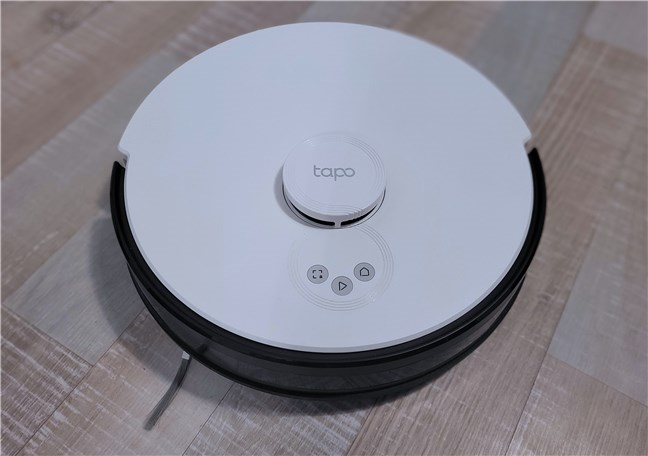
The Tapo RV30 Plus has a standard size for a robot vacuum
The top of the Tapo RV30 Plus houses the LiDAR (laser imaging, detection, and ranging) system and three control buttons. The laser navigation system works together with a gyroscope to accurately map and navigate your home, as well as avoid obstacles. It also allows the robot vacuum to perform its duties during nighttime. The buttons on the Tapo RV30 Plus let you Start/Pause a cleaning run, Dock the device (send it home to its station), and initiate a Spot Cleaning. For the latter, you must manually place the robot vacuum in the spot you want to clean, and it will remove dust and debris in a rectangular area of 1.5 meters by 1.5 meters (4.9 feet by 4.9 feet), starting from the center.
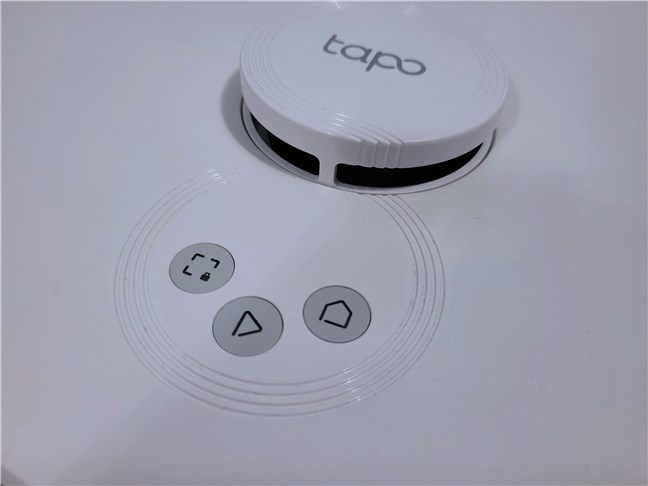
The buttons found on the robot vacuum
The front side of the Tapo RV30 Plus is covered by a large bumper that goes from one side to the other. It protects the robot vacuum when hitting obstacles, and the recharge sensors behind it help the device dock when it finishes cleaning.
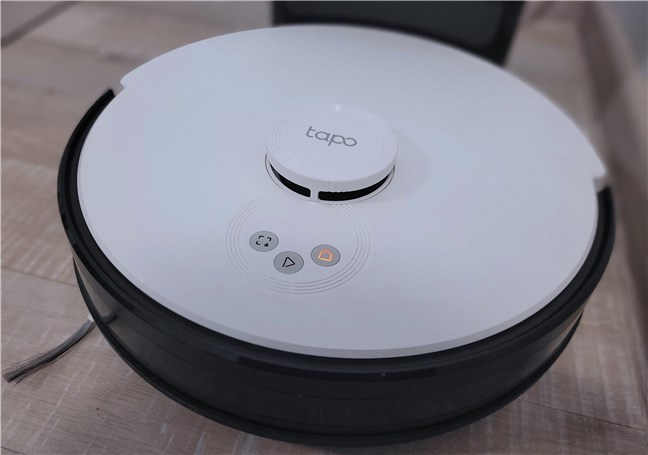
The front side is covered by a bumper
Underneath the device, there’s a slew of items and parts. At the front, there’s a cliff sensor for anti-drop protection (two others are found on the left and right sides) and a caster wheel that allows the robot vacuum to change its direction 360°. Then comes the side brush (front-left as seen from the bottom, front-right as seen from above), the two main wheels (which allow the device to climb over obstacles with a maximum height of 2 cm/ 0.79 in), and the detachable main cleaning brush between them. Last but not least, about a third of the bottom area is covered by the mop pad.
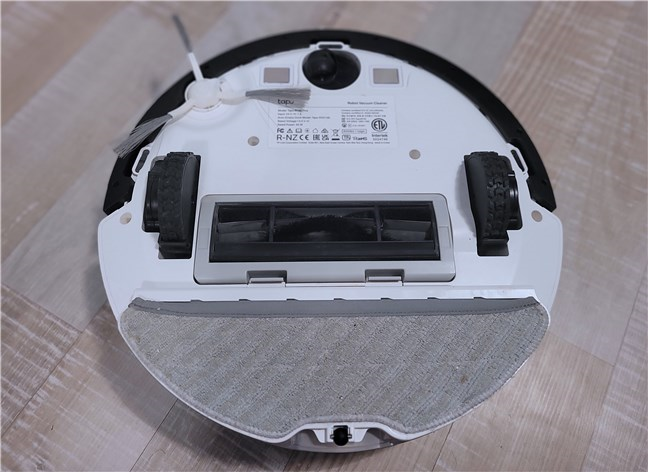
The bottom of the TP-Link Tapo RV30 Plus robot vacuum
TP-Link advertises the Tapo RV30 Plus as offering a maximum suction power of 4200 Pascals. This value is higher than what many similar devices offer, and it should translate into excellent performance when removing dust from carpets and even debris stuck between floorboards. The robot vacuum features four suction power levels, depending on your requirements or preferences. Furthermore, the Tapo RV30 Plus includes a HEPA filter (a must-have for those suffering from allergies) and a large 350 ml dustbin.
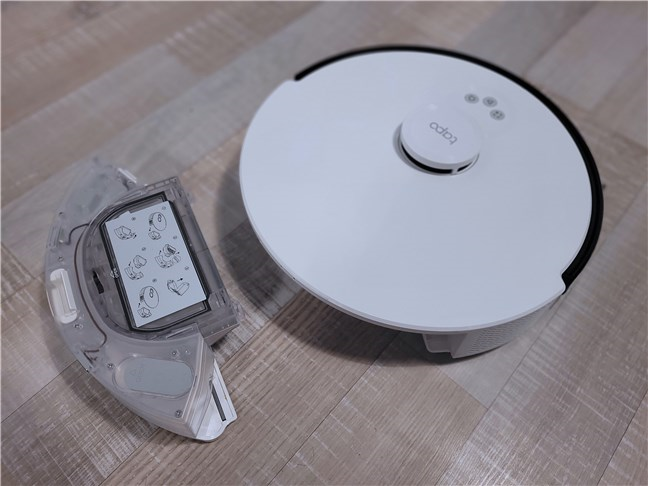
This robot vacuum has a HEPA filter
Mopping is essential for many homes, especially for those with hard floors and few carpets. The Tapo RV30 Plus has this ability, too, bundling a generous 300 ml water tank that can theoretically be enough to cover up to 200 square meters (2100 square feet). Moreover, the robot vacuum benefits from an electric water flow control system that lets you adjust how much water is used when mopping using three different levels.
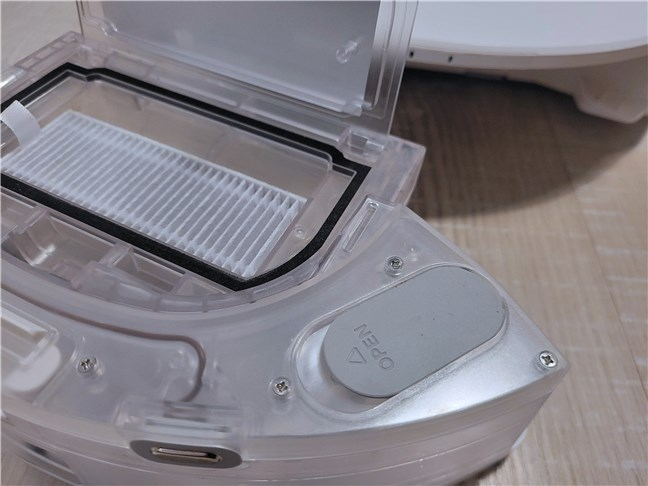
The water tank used for mopping has a fairly large capacity
In terms of battery life, TP-Link says that the Tapo RV30 Plus can run cleaning jobs for up to three hours on a single charge, thanks to a built-in 5000 mAh battery. In real life, this will be significantly influenced by how you use the robot vacuum. A higher level of suction power will definitely decrease the device’s autonomy.
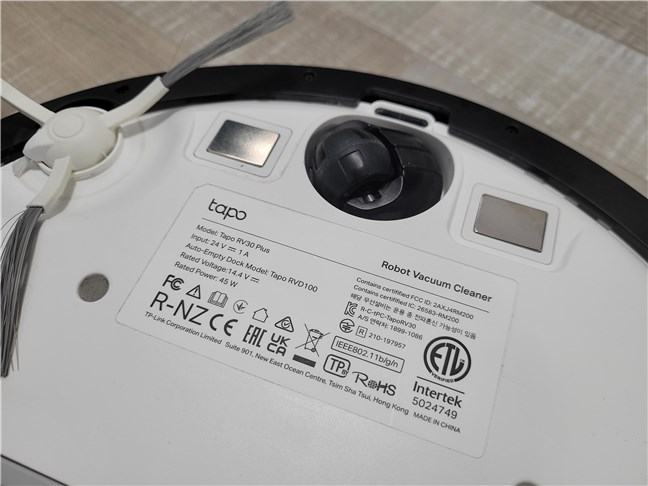
The autonomy is delivered by a 5000 mAh battery
The Tapo RV30 Plus also comes with a smart auto-emptying docking station. Unlike what I’ve seen on other similar devices, the station of this robot vacuum is quite small. Still, its storage capacity is generous. The dock’s design is based on the same black and white colors used on the robot vacuum and features an LED that notifies you when you should remove the dust bag.
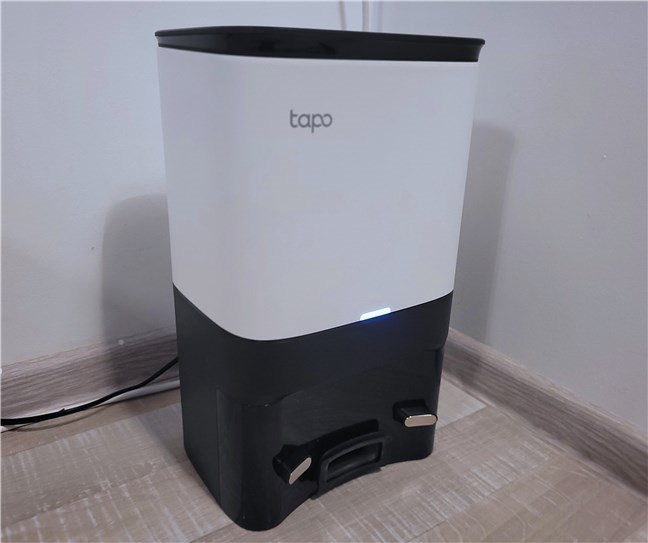
The auto-emptying docking station
Measuring 22.55 cm in width, 19.4 cm in depth, and 38.13 cm in height (8.9 × 7.6 × 15 inches), the dock has a suction power of 27000 Pascals and a dust storage capacity of 4 liters. In optimum conditions, a dust bag should suffice for up to 70 days without emptying, after which you’ll need to replace it.
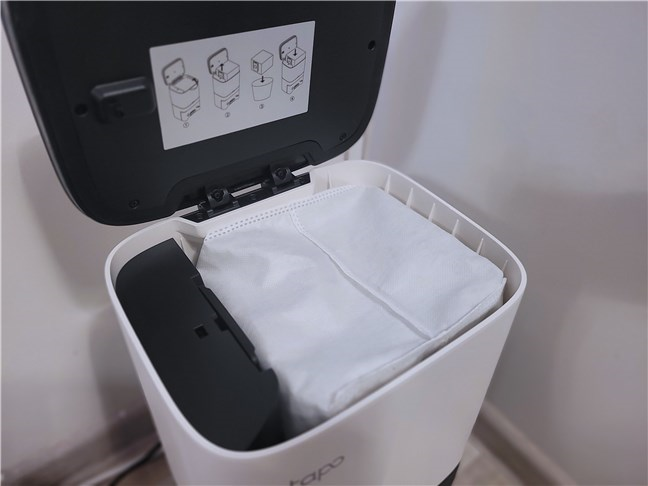
The dust bags have a large volume of 4 liters
Before moving on to the actual user experience offered by the TP-Link Tapo RV30 Plus, I should also mention two aspects regarding its connectivity and integration. First, the robot vacuum works by connecting to Wi-Fi 4 networks (802.11 b/g/n) only on the 2.4 GHz band. It also has a Bluetooth 4.2 chip inside, but that’s used only for the initial pairing with the Tapo app. Regarding integration, the Tapo RV30 Plus is compatible with Amazon Alexa and Google Home, allowing you to control it via smart speakers too, not just through TP-Link’s smart home Tapo app.
For more specs and technical information, visit the product’s official page: TP-Link Tapo RV30 Plus.
The TP-Link Tapo RV30 Plus is a smart robot vacuum that can conveniently clean your home. It has a compact design and a high suction power that allows it to pick up dust, dirt, hair, and crumbs from all kinds of floor types. Thanks to its 360° laser navigation system, large dustbin, and long battery life, it could be an excellent choice for larger apartments and houses.
Using the TP-Link Tapo RV30 Plus
I’ve been using the TP-Link Tapo RV30 Plus robot vacuum for about two weeks now, and I’m quite impressed with its performance. Here’s how to set it up and what to expect from it when cleaning and mopping your home:
Setting up the TP-Link Tapo RV30 Plus
After unboxing the TP-Link Tapo RV30 Plus and reading its user manual (everyone should do that!), choose where to place the docking station: I decided to put it in a corner of my living room. The next step was to install the Tapo app on my Android smartphone. If you’re using an Android, you can get it from Google’s Play Store, and if you have an iPhone, you can download it from Apple’s App Store. Regardless, once you have the app on your phone, launch it and sign in or create an account if you don’t have one. Then, navigate the app and select the Tapo RV30 Plus option from the list of robot vacuums.
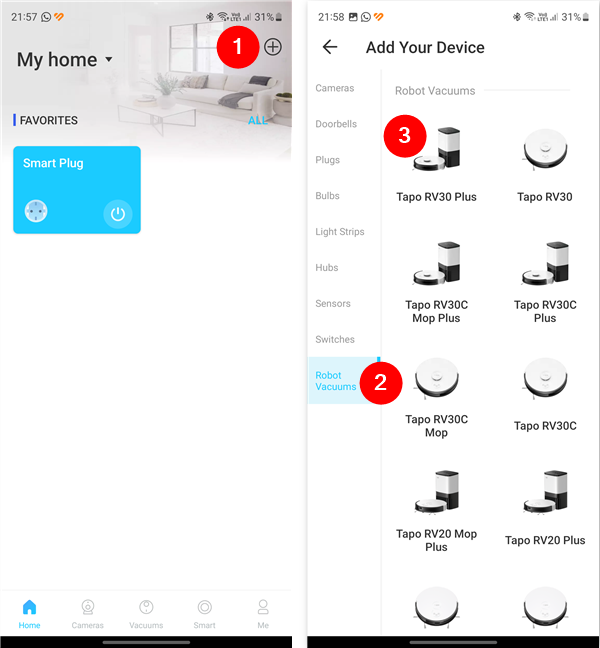
Adding the TP-Link Tapo RV30 Plus to the Tapo app
The Tapo app then guides you through all the steps required to add the TP-Link Tapo RV30 Plus. First, you’ll need to remove the protective strips on the device and power it on. Plug the station into a power outlet, attach the robot vacuum to the station, and turn On the switch found on the right side of the device (as looked at from its front).
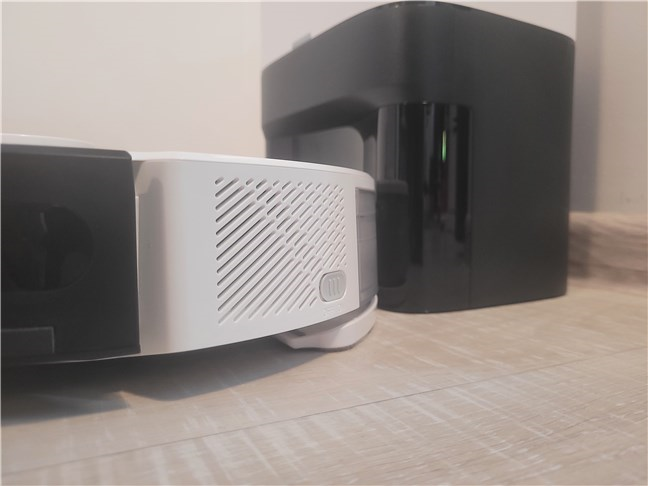
Powering the robot vacuum on
Next, just like instructed by the Tapo app, you need to make the robot vacuum enter setup mode. This is done by simultaneously pressing the Spot Cleaning and Dock buttons on the robot vacuum for 5 seconds.
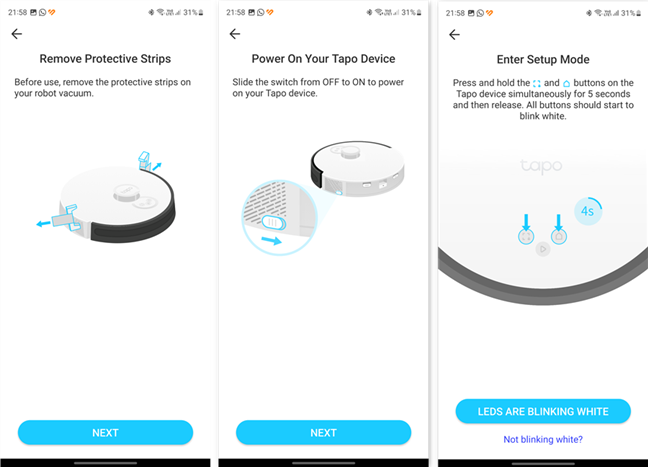
Entering the setup mode of the TP-Link Tapo RV30 Plus
After making sure that Bluetooth is enabled on your smartphone, the app continues to set up the robot vacuum. Once they finish pairing, you must select the Wi-Fi network to which you’ll connect the device. Remember that only Wi-Fi 4 connections are supported.
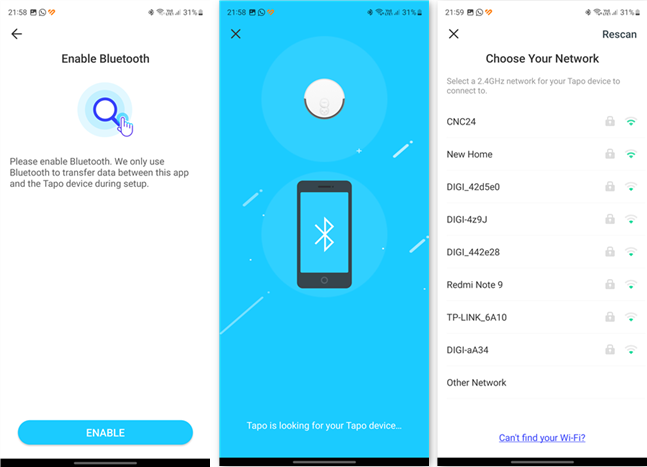
Connecting the robot vacuum to Wi-Fi
Once the Tapo RV30 Plus is connected to your Wi-Fi, you can choose a name and a location for it. Then, the app automatically checks whether there are any firmware updates available for the robot vacuum. If there are, you’re notified and asked to install the latest. Furthermore, automatic overnight checks for updates are also set in place. This is an excellent approach in terms of security.
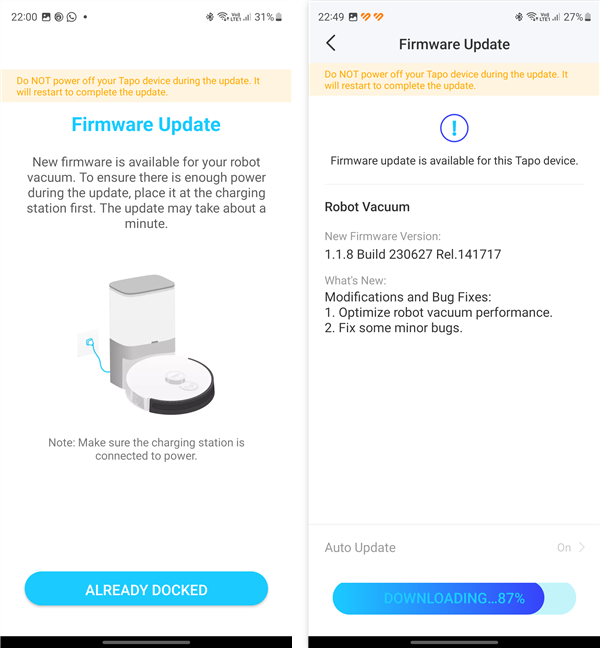
Firmware update for the TP-Link Tapo RV30 Plus
The TP-Link Tapo RV30 Plus robot vacuum is now almost ready to use. However, before you can actually say that you’re done with the basic configuration, you need to map your home. This task is performed very quickly, as the robot vacuum doesn’t do any actual cleaning. It only scans the surroundings to identify walls, doors, furniture, and any obstacles present. Once it’s done, you can edit the map, give names to your rooms, merge or divide the ones that the robot vacuum didn’t identify as you wanted, and create zones and virtual walls. However, you can also do all this later on.
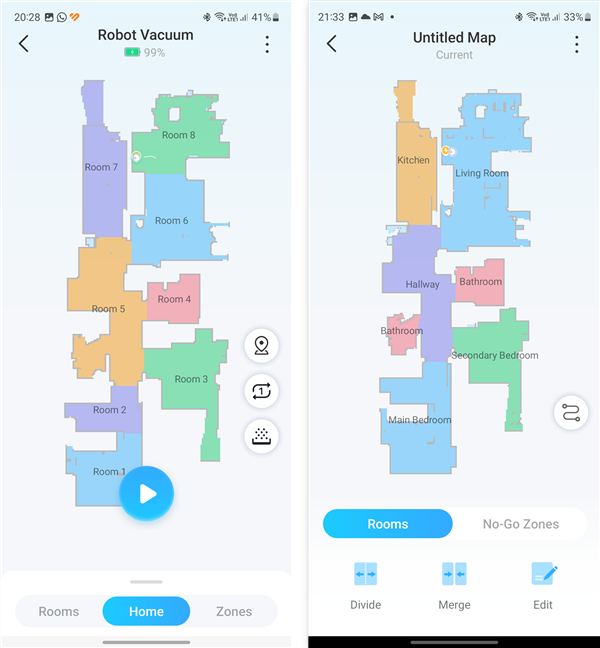
The robot vacuum mapping my home
TP-Link’s Tapo app allows you to control the RV30 Plus robot vacuum from anywhere you find yourself. Obviously, the sole condition is that your smartphone has an internet connection. In my testing, I’ve found that the app is quite complex and offers many features, options, and settings. However, everything’s easy to find, understand, and use, so it won’t take long to get a grasp of what you can do. Besides asking the Tapo RV30 Plus to clean your home, the app lets you adjust the suction power and cleaning mode, view the cleaning map and the task history, as well as see where the device has cleaned and where it stumbled upon issues.
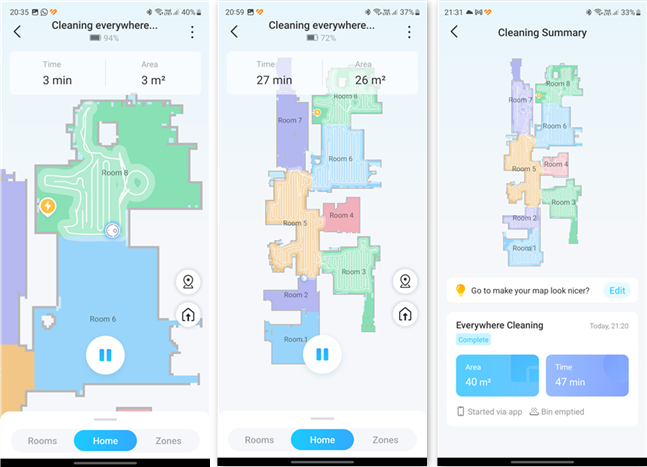
Cleaning my home with the TP-Link Tapo RV30 Plus robot vacuum
Furthermore, with the Tapo app, you can also schedule cleaning tasks (including for different rooms and times), monitor battery level and cleaning status (time and areas cleaned), set how often the dust collector is emptied in the docking station, choose the suction power when vacuuming carpets, and so on. You also receive alerts if the robot vacuum encounters issues. For example, you’re notified when the battery is low, when the robot vacuum gets stuck, or when the dustbin is full, and you need to replace its dust bag.
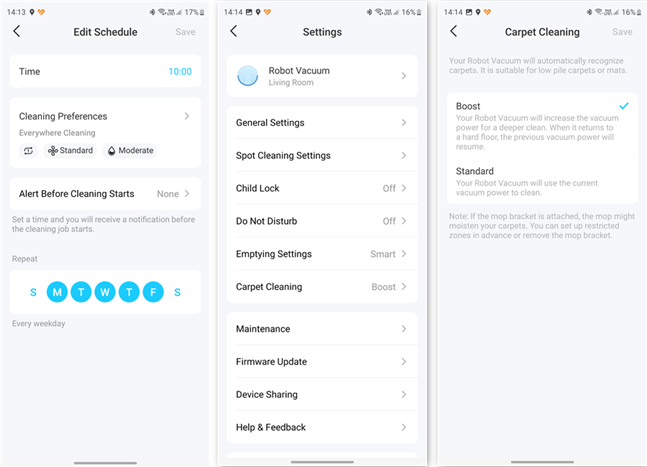
Settings available for the robot vacuum
In my opinion, the TP-Link Tapo app does an excellent job, offering a convenient way to control the Tapo RV30 Plus robot vacuum. It has all the features, options, and settings you need in order to control and configure your device.
Cleaning and mopping your home with the TP-Link Tapo RV30 Plus
In my tests, the TP-Link Tapo RV30 Plus manages to do an excellent job at cleaning dust, dirt, and other debris on hard floors. Its suction power is strong, and to be honest, I didn’t notice any significant difference between the four modes available. Running in quiet, standard, turbo, or max mode, the cleaning results I got from the robot vacuum were similar. As such, I think it’s best if you use it in either quiet or standard mode, as that will give you the perfect balance between performance, noise level, and battery life.
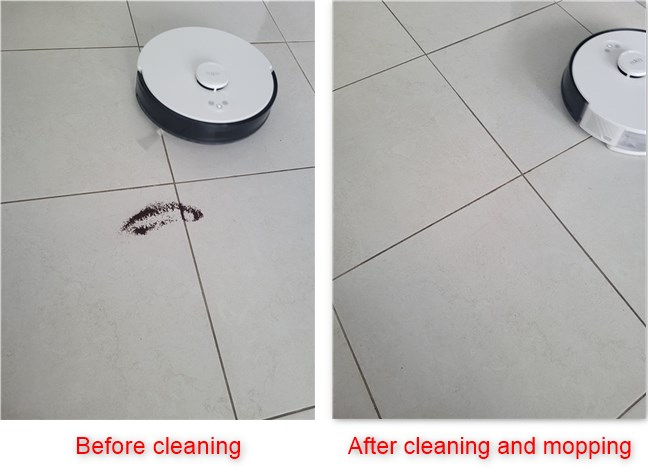
TP-Link Tapo RV30 Plus vacuuming and mopping (before and after)
Mopping is okay, but it’s not perfect. Just like many other robot vacuums in this price range, the Tapo RV30 Plus uses a pad with an attached cloth to wet and wipe behind it. However, unlike what I’ve seen on other robot vacuums, the water level flow is better. For instance, on my old (but trusted) Xiaomi Mi Mop Pro, the highest level of water flow is similar to the medium level on the TP-Link Tapo RV30 Plus. When using the latter to mop around my home, I could actually see the floors shining behind it. While that gives me confidence in the robot vacuum’s mopping ability, don’t expect any miracles: it works well for regular smudges like new or superficial stains and muddy footprints, but not so much if your floors are full of old stains. In such a situation, the Tapo RV 30 Plus will have issues wiping deeper stains and hardened spots like those you can get in the kitchen after a day or two of avoiding cleaning it.
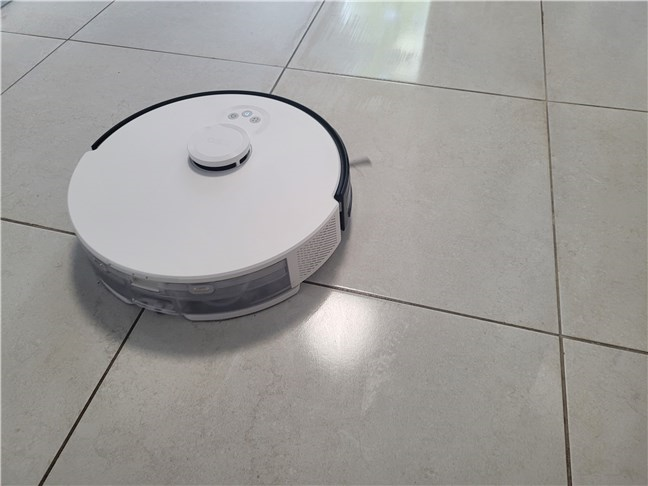
TP-Link Tapo RV30 Plus mopping
The LiDAR and gyroscope navigation system used by the TP-Link Tapo RV30 Plus is above average. Never once did I see it get stuck during the two weeks I used it. Its smart navigation system maps the rooms perfectly, and the cleaning paths it chooses appear to be optimal. At least, that’s the impression it gave when looking at the speed of cleaning: about one square meter in a minute. Furthermore, besides avoiding drop-offs, the robot vacuum is also able to resume cleaning from where it left off if it runs out of battery. The only part where it falls short is the handling of obstacles: while it has no issues getting around furniture and any other things blocking its path, I can’t say it’s excellent because it has a habit of colliding with them rather violently (check the video recording further down in this review to see what I mean).
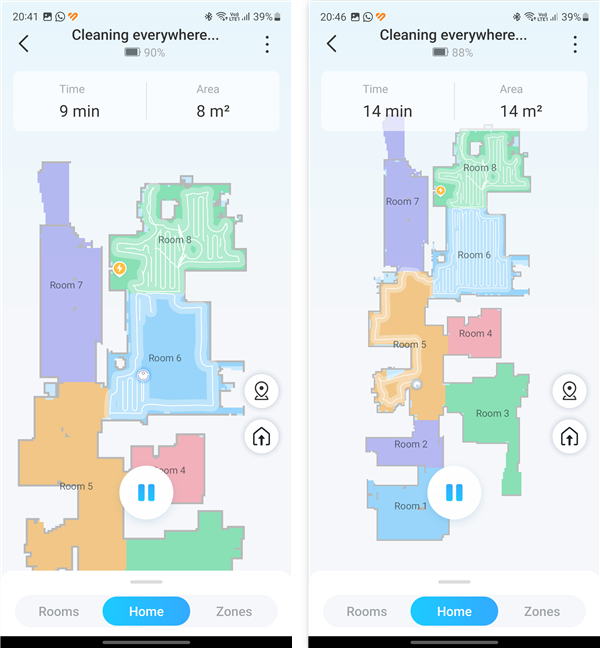
The navigation system is excellent
I also found the Tapo RV30 Plus to be really quiet while operating. In standard mode, it buzzes; in quiet mode, what you hear is more of a humming than a vacuum cleaner. However, when setting its suction power to turbo or max, the noise generated is quite high. And as I also mentioned earlier, the cleaning performance offered by the device is similar regardless of the suction power mode used, so I’d stick with either standard or quiet. According to TP-Link, the Tapo RV30 Plus features a built-in noise suppression system with a special duct design, acoustic cotton that absorbs sound, and a dynamic balance fan. This allows the robot vacuum to generate as little as 55 dB when running in quiet mode. On the other hand, because of its increased suction power, the docking station is very loud when absorbing dust and dirt from the robot vacuum. Thankfully, this process is fast, so you won’t have to endure the loud noise for long. To get a clearer picture, I made a clip where you can hear for yourself how noisy the TP-Link Tapo RV30 Plus is in each cleaning mode, as well as how loud the docking station is.
After finishing a cleaning task, the TP-Link Tapo RV30 Plus goes back to its docking station to recharge its battery. It takes a while, but not as long as other similar robot vacuums. Going from 19% (this is when the device enters low-battery mode and goes to the dock to charge) to one hundred percent takes about two hours and twenty minutes. Furthermore, the robot vacuum’s battery life is quite good and should suffice for a whole-home cleaning of larger-sized apartments and average-sized houses. For instance, my flat has a total surface of about 71 square meters, but the actual floor area that is cleaned by the robot is about 40 square meters. The rest is covered by furniture and other appliances. After cleaning my entire home (cleaning and mopping, standard mode, moderate water flow), the Tapo RV30 Plus was left with about 89% of battery, which is great.
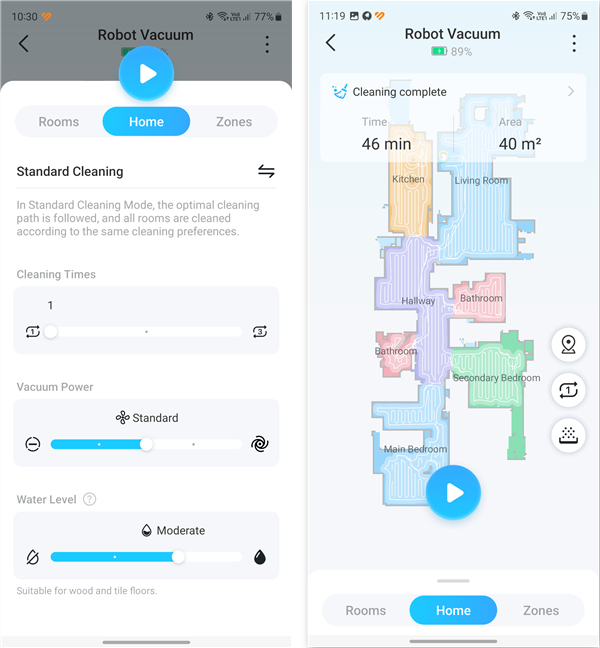
The robot vacuum's battery life is long
Removing the dust bag from the docking station is easy and convenient. The dust bags are made of a cloth that, just like the HEPA filter inside the robot vacuum, traps not just regular dust but also smaller particles and dust mites that trigger allergies. As that’s something I suffer from, I really appreciate this care for health. Furthermore, the dust bags are large, able to fit a maximum volume of 4 liters of dust and dirt. According to TP-Link, it means that you have to remove and replace the dust bag once every 70 days in normal scenarios, although this time may be shorter if your home tends to be dusty. Unfortunately, I didn’t have the robot vacuum for that long, so I can’t say how often you really need to replace the bag. Worth noting, the robot vacuum’s box bundles a second dust bag, so you should be set for at least three or four months.
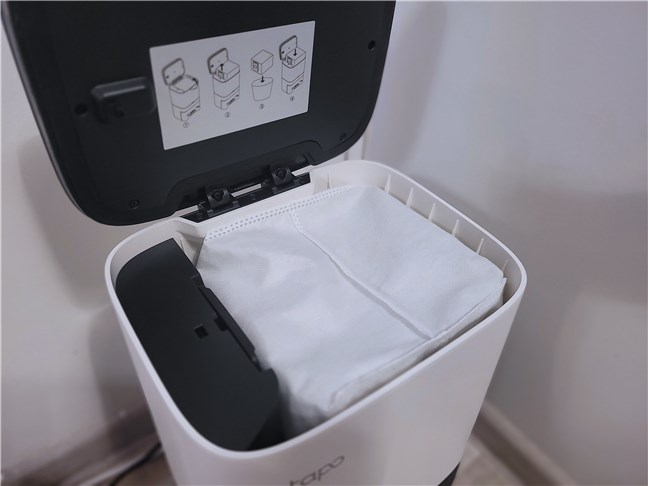
The dock is a convenient addition to the robot vacuum
Just like any other robot vacuum, the Tapo RV30 Plus is a device that requires some maintenance from time to time. In other words, besides removing the dust bag and emptying the water tank when required, you also need to periodically clean and/or replace its main brush, side brush, and HEPA filter. Fortunately, you won’t have to make notes in your calendar because the Tapo app monitors usage and notifies you when you must replace any of the above. The main brush needs to be replaced every 400 days, while the side brush and HEPA filter every 200 days. And another good news is that the package of the Tapo RV30 Plus also includes a spare side brush and a spare HEPA filter, which means that you’re covered for a total of 400 days (about a year and a month’s time).
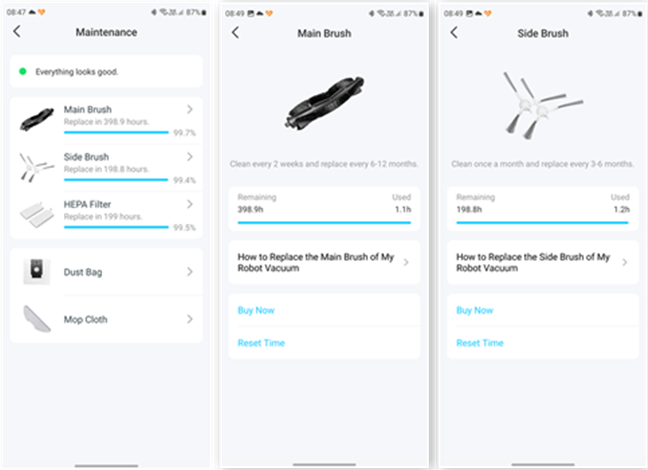
The Tapo app notifies you when you need to make replacements
One other feature of TP-Link’s Tapo app that you might enjoy is its ability to automate tasks for your robot vacuum. Besides creating schedules, I appreciated the option to create shortcuts, scenes, and smart actions that allowed me to control when and how the robot vacuum cleaned my home. For example, I set a schedule to start the Tapo RV30 Plus every day at 9 AM, but I also made a shortcut that allowed me to quickly activate the robot vacuum whenever I left home. If you have other smart devices from TP-Link, you can also create scenarios that trigger the robot vacuum based on those other devices.
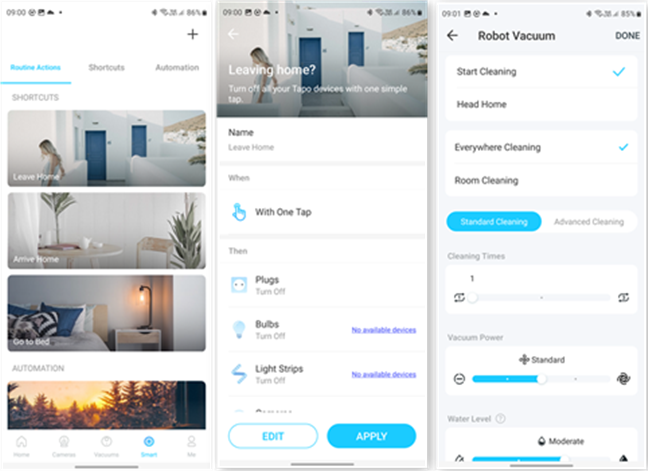
The Tapo app lets you create schedules, scenes, and shortcuts
Moreover, I’ve also connected the Tapo RV30 Plus to Alexa using the Tapo app, and everything worked out perfectly, allowing me to speak to trigger the robot vacuum in no time. You should know that you can also integrate the device with Google Home if you prefer it to Amazon’s Alexa.
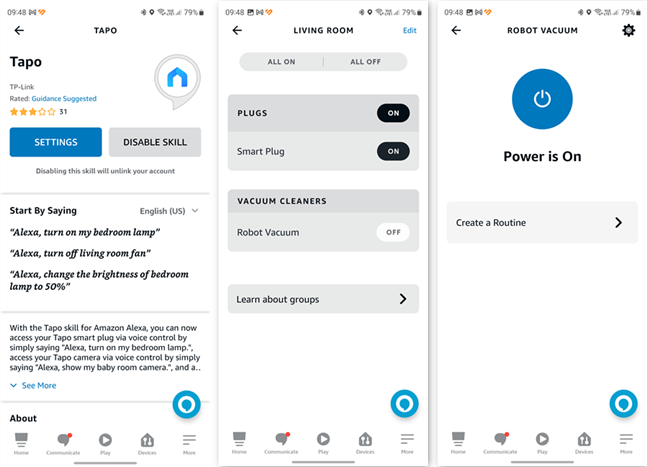
The robot vacuum works with Amazon Alexa
Overall, I’m satisfied with the TP-Link Tapo RV30 Plus robot vacuum. It’s an easy-to-use, efficient, and reliable device, saving me a lot of time and energy in keeping my home clean and tidy. Its navigation system is top-notch, the suction power is high, the mopping feature works well, and the auto-empty docking station means less maintenance. Furthermore, the Tapo app has everything I need and want, including integration with voice assistants. The only thing you should be careful about is not to mop carpets without intention. 🙂 Otherwise, the Tapo RV30 Plus feels like a robot vacuum that’s for everyone, with a great balance between price and performance.
What do you think of the TP-Link Tapo RV30 Plus?
Now you know more about what the TP-Link Tapo RV30 Plus robot vacuum has to offer in terms of design, features, and cleaning performance. What do you think? Is it worth your money? Would you buy it for your home? Let me know your opinions in the comments section below. Also, if you’d like us to keep you informed with our latest reviews and guides, don’t hesitate to subscribe to our newsletter.






